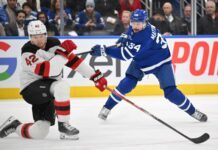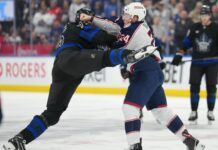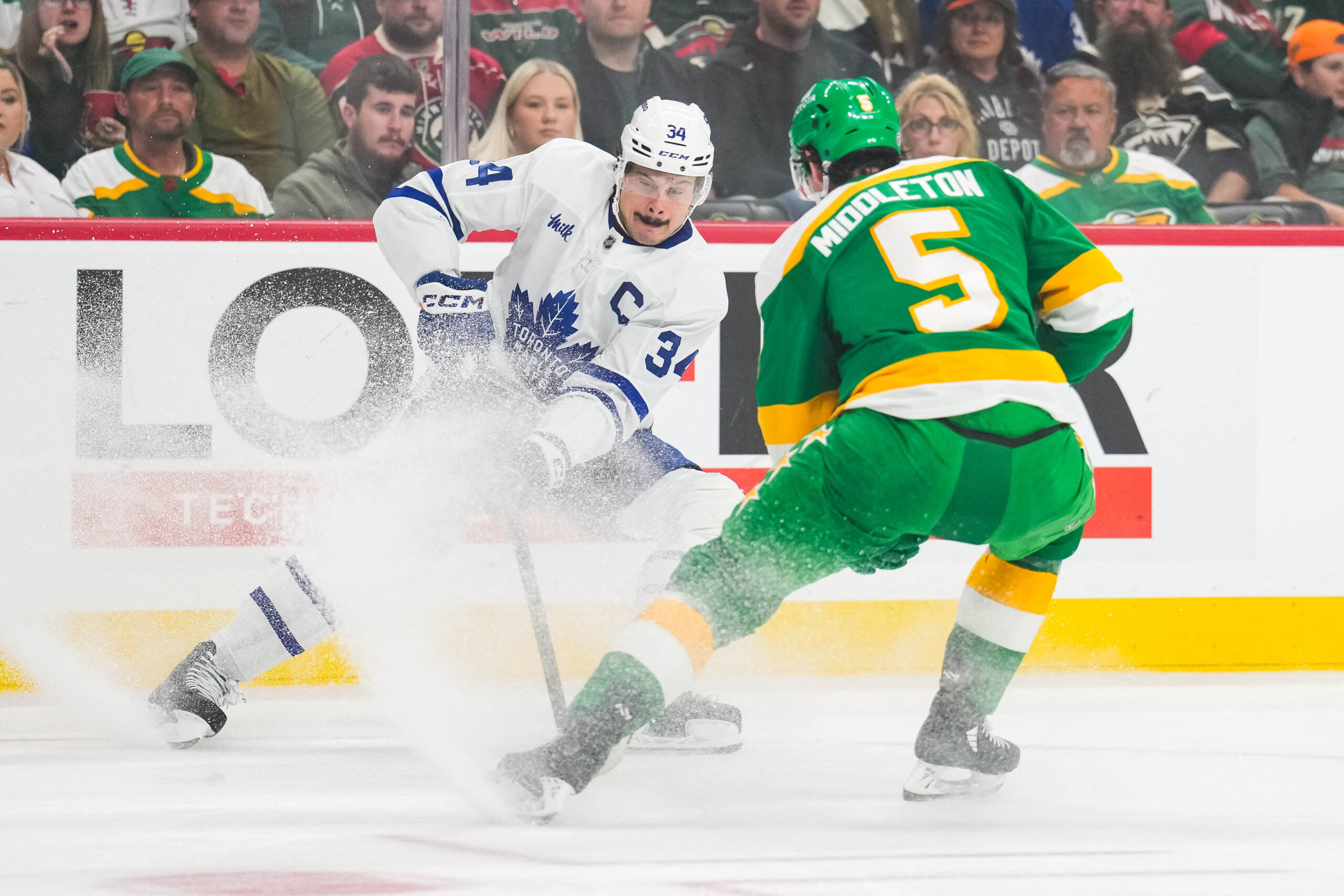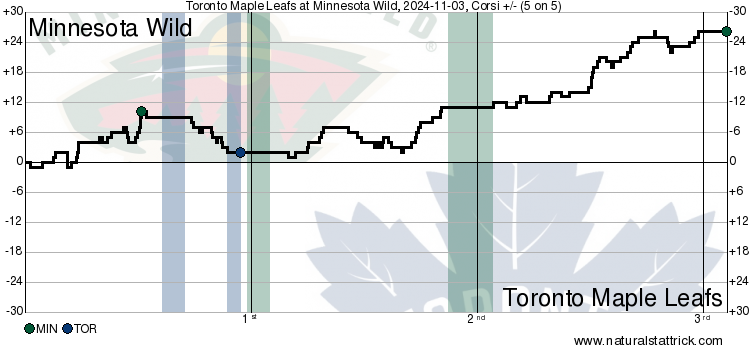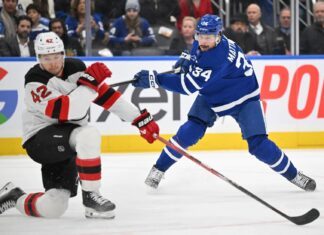The better team on this night won the game, but anyone in the league would tell you that this game is a “schedule” loss in the Maple Leafs’ situation. A loser point is a decent result, all things considered.
Similar to what we said yesterday, though, the game continued to highlight the Leafs‘ lack of depth. They need some contributions up and down the lineup if they are going to succeed in back-to-back situations. As it was, they went 0-1-1 this weekend and play the Bruins next before another back-to-back next Friday-Saturday.
Your game in 10:
1. Entering the game, the Wild were 7-2-1, one of the best starts in the league. They were also a rested team at home playing a tired team that traveled last night.
The Wild are deep up front and are led by Kirill Kaprizov, who came into this game leading the league in scoring. This presented an interesting conundrum: The Wild owned the last change at home and would surely want to match Joel Eriksson-Ek, their shutdown center, against the Auston Matthews line, freeing up Kaprizov to run up against the John Tavares line.
That’s exactly how the Wild approached this game. The Leafs sent out the Tavares line to start the opening draw, and the Wild countered with the Kaprizov unit. The Tavares line isn’t exactly a shutdown or stout defensive line, but that is why the coaching staff has paired them with the Jake McCabe – Chris Tanev pairing — a shutdown duo that provides the offense-focused Tavares line with some balance and real support defensively without killing them offensively.
The chess game played out throughout the night. As the game wore on, the Wild looked to slide Kaprizov out against the Domi unit while the Leafs ultimately tried to stick with the Tanev pairing in the matchup. McCabe and Tanev certainly did their part, as Kaprizov didn’t record a point in this game.
2. At the start of the game, the Leafs looked slow and sluggish, but Anthony Stolarz was ready for the task. He made a stand-out diving save on a high slot one-timer by Mats Zuccarello, and Oliver Ekman-Larsson also made a great diving poke check to knock the puck off Karpizov on an early 2v1 for the Wild.
Minnesota did a good job clogging the neutral zone, and the Leafs couldn’t break through, committing several turnovers. Pucks weren’t put in deep, so the Wild quickly countered up ice. The Wild were getting zone time partly because the Leafs simply couldn’t sustain any offensive-zone time even when they did possess the puck.
3. Halfway through the period, the Wild were rewarded with a goal for all their pressure. The whole sequence pretty well summed up the start to the game as the Wild hemmed the Leafs in their zone for roughly half a minute against an out-of-gas unit featuring the Tavares line along with the Simon Benoit – Conor Timmins pairing. They couldn’t win a race to a puck or a battle to stop the cycle or get a whistle/line change.
The Wild launched three point shots in a row and recovered every puck, the last of which was a rebound that was then shot off the post and bounced behind Stolarz. In a scrum between Hartman and Tavares, the puck took a bit of an unlucky bounce off Tavares’ stick and into the net. While that part of it was unlucky, it resulted from a shift bound to end poorly. When the Wild scored, they were up 11-3 in shots on net.
4. After the Wild scored, I wouldn’t exactly suggest the Leafs “pushed back,” but they started to tilt the ice the other way and generate some zone time and looks in the offensive zone with a better forecheck. A few minutes after falling behind, they were gifted a power play courtesy of an undisciplined penalty by Kaprizov.
The Leafs trotted out a five-forward unit with Mitch Marner at the point, William Nylander and Auston Matthews on the half-walls, Matthew Knies in front, and John Tavares in the bumper. We saw Marner play defense last year at times, and he looked comfortable controlling the puck up top. The Leafs were able to work it around but struggled to create a grade-A chance.
Halfway through the power play, Tavares and Knies were subbed out for Bobby McMann and Max Pacioretty. They created some decent looks, but ultimately, they didn’t score (again). After the Wild killed the penalty, Matt Boldy had a chance off the rush alone in front, but Stolarz made another good save to keep it a one-goal game.
5. In the dying minutes of the period, the Leafs’ top line generated some pressure when Marner grabbed the puck at the point and made a nice move around Marco Rossi for a scoring chance, drawing a penalty in the process. The five-forward unit came out again, and this time, they managed to finally score the Leafs’ first road power-play goal of the season (on November 3 in game #13!).
With possession in the zone, the Leafs worked it to Marner, who took control of the puck at the top of the circle and skated to his spot at the top of the point. Marner passed off to Matthews, who dipped lower on the half-wall and wasn’t really positioned to shoot. Matthews held the puck and waited for the cross-ice lane to open up as he gave Marner a quick look, then feathered a nice pass through the slot to Nylander on the far side half-wall, where Nylander one-timed it home.
It was a nice finish and play by the stars, and it bumps the monkey off their back, hopefully allowing them to relax and clear their minds. However, it’s a tough goal to consistently replicate—standing still and feathering a pass through an entire penalty-killing unit.
"HOLY MACKINAW! THE POWER PLAY HAS CLICKED!"
NYLANDER TIES IT courtesy of @Bonsie1951 and @Jim_Ralph. @LeafsJelly pic.twitter.com/N8WHGEU7qU
— Maple Leafs Hotstove (@LeafsNews) November 3, 2024
6. After scoring, the Leafs took a penalty to end the period and started the second on the penalty kill. Their penalty kill was solid in this game, and they killed it off, but shortly afterward, the fourth line came out and was hemmed in their zone. The Leafs had real problems clearing pucks all night—not just the fourth line—and the Wild controlled the play.
During the sequence, though, Hartman engaged with Simon Benoit and Ryan Reaves jumped in, eventually leading to coincidental minors and 4v4 hockey. The Leafs created the best chance with the open ice as a Matthews shot rebounded out to OEL, who one-timed it, but Gustavsson slid across to make a nice save.
It’s curious that the Leafs run a Domi-Nylander consistently as their second 4v4 man unit over Tavares or Knies. Presumably, the Leafs are looking for speed, but I’m not sure Domi has earned it or done anything with it to suggest he should be on the second 4v4 unit over better overall players than him.
The only other real highlight in the second period for the Leafs was Benoit running Hartman along the boards and the ensuing scrum.
7. The pivotal moment in the game for the Leafs came towards the end of the second period as Oliver Ekman-Larsson took a double minor — a penalty for cross-checking during the play and a roughing penalty after the whistle, which was somewhere between unnecessary on OEL’s part and unnecessary on the refs’ part.
Nonetheless, the Wild went to a full four-minute power play against a Leafs team that was beginning to run on fumes, but the Leafs held firm. The Auston Matthews–Mitch Marner duo has quietly started to take strides as a penalty-killing unit. When they played together last season, it seemed many thought it was fun because of how they counterattacked and looked for offense, but this season, they have started to tone it down and focus on actually killing penalties. The Leafs ran two penalty-killing duos up front in this game, and they looked good: Matthews – Marner and David Kampf – Matthew Knies.
Kampf should be a regular penalty killer despite the way the Leafs have used him so far this season. Alongside Knies, they did an excellent job, and the Leafs should eventually get Connor Dewar and Calle Jarnkrok back, helping give their top offensive players some breaks.
8. For most of the third period, the Leafs looked like a tired team playing a rested team. The Wild spent the vast majority of the period in the Leafs’ end, and shot attempts were 25-9 in Minnesota’s favour.
Anthony Stolarz was excellent as the Wild continually sustained pressure and launched shots from all over the zone while crashing the net. That’s an exhausting game for a goalie, dealing with not only the constant shot volume but mentally needing to stay dialed in the entire time; the puck is always in the defensive zone, and a tired team in front of him isn’t providing him with many breaks.
The Leafs had very little in the way of chances the other way, but towards the end of the period, Steven Lorentz fired a pretty good shot off the rush, as did Pacioretty, and there was one shift where Conor Timmins launched a few pucks from the point with Pacioretty in front that were sneakily dangerous. The Leafs top line didn’t register a shot in the period.
9. This game is also a good example of the Leafs putting themselves behind the eight ball. They were clearly gassed, but they still dressed Ryan Reaves, who played all of 6:26. Towards the end of the third, William Nylander was taking shifts on the fourth line in his place.
It’s not that Pontus Holmberg has been great this season or anything, but he has younger legs, and the team can get more than six and a half minutes from him, allowing them to rest the other players a little more and try to squeeze more juice out of the group across the board. There is a domino effect at play.
Similarly, Nylander played just 17:46, and if there’s one player who can always skate on this team, it’s Nylander. It’s early in the season, and the coaching staff has to learn the team, but they left minutes on the board in this one, which hurts the cause when the team is already gassed.
10. In overtime, the Leafs lost the opening faceoff and never really possessed the puck from that point onward. There was one rush where Marner somewhat held possession, but they couldn’t create anything. Otherwise, the Wild continued to wear the Leafs down.
When the Leafs were able to create a turnover, instead of Max Domi controlling it and making a real play with the puck, he shot it up the ice and chased it, while OEL made a bad read by changing as Domi easily lost the race to the puck. Spurgeon, who won the race, noticed the line change and quickly spun to rip the puck back up the ice. On the resulting 2v0, Matt Boldy walked in and scored to ice the game.





